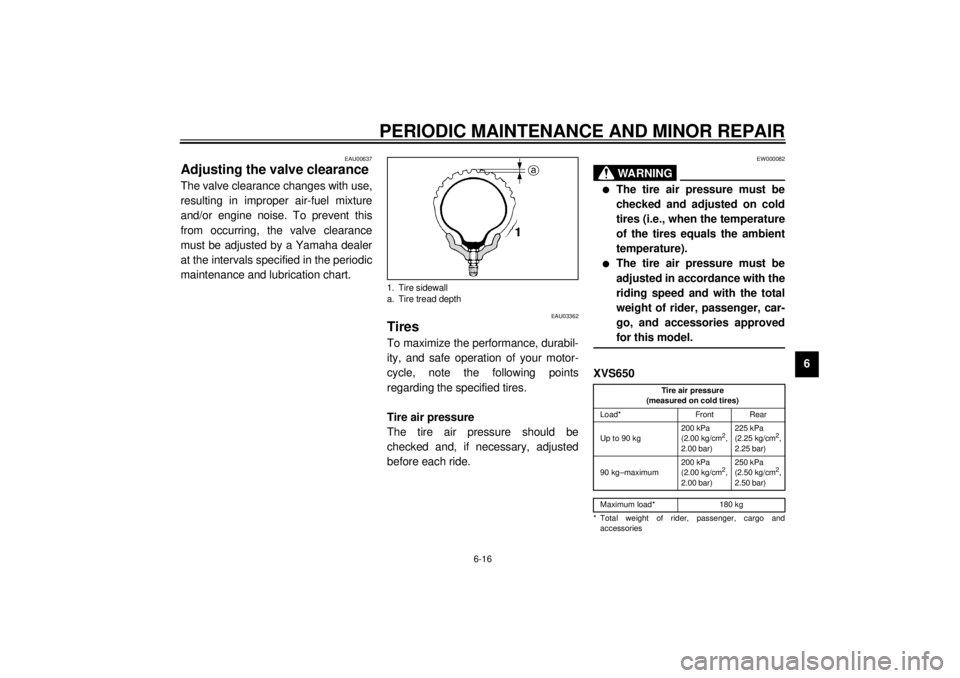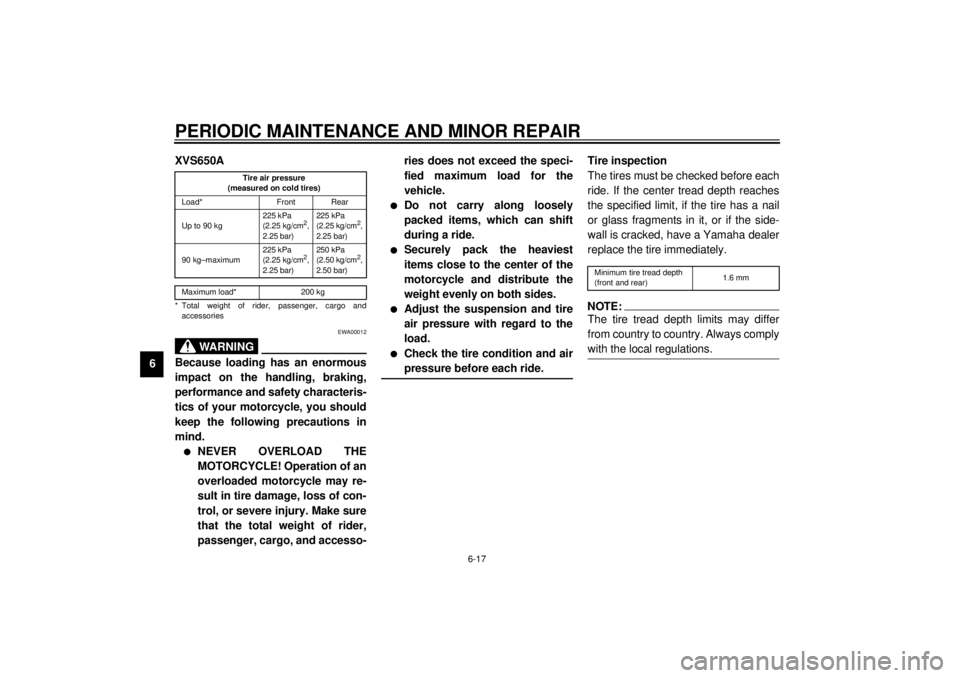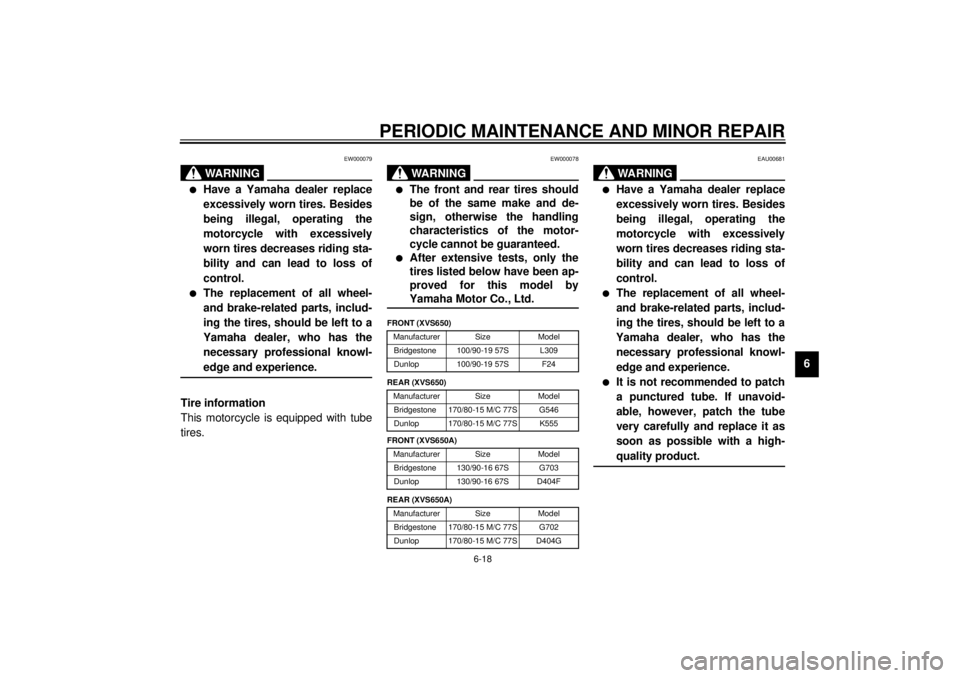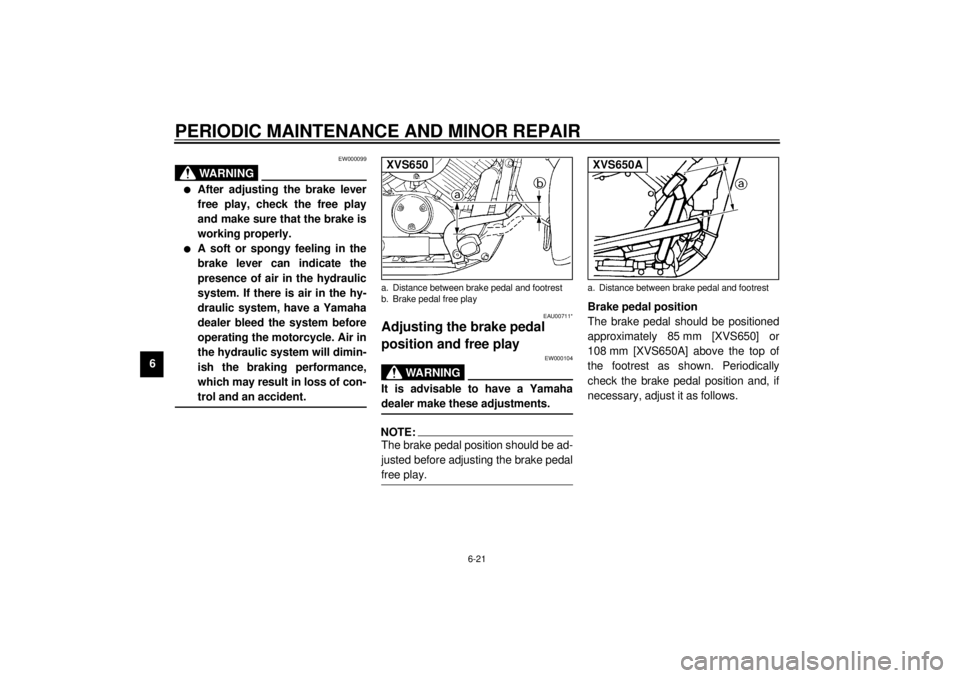warning YAMAHA XVS650 2001 User Guide
[x] Cancel search | Manufacturer: YAMAHA, Model Year: 2001, Model line: XVS650, Model: YAMAHA XVS650 2001Pages: 106, PDF Size: 16.06 MB
Page 40 of 106

5-1
5
EAU00372
5-OPERATION AND IMPORTANT RIDING POINTS
EAU00373
WARNING
@ l
Become thoroughly familiar
with all operating controls and
their functions before riding.
Consult a Yamaha dealer re-
garding any control or function
that you do not thoroughly un-
derstand.
l
Never start the engine or oper-
ate it in a closed area for any
length of time. Exhaust fumes
are poisonous, and inhaling
them can cause loss of con-
sciousness and death within a
short time. Always make sure
that there is adequate ventila-
tion.
l
Before starting out, make sure
that the sidestand is up. If the
sidestand is not raised com-
pletely, it could contact the
ground and distract the opera-
tor, resulting in a possible loss
of control.
@
EAU03461*
Starting the engine In order for the ignition circuit cut-off
system to enable starting, one of the
following conditions must be met:l
The transmission is in the neutral
position.
l
The transmission is in gear with
the clutch lever pulled and the sid-
estand up.
EW000054
WARNING
@ l
Before starting the engine,
check the function of the igni-
tion circuit cut-off system ac-
cording to the procedure
described on page 3-17.
l
Never ride with the sidestand
down.
@
1. Turn the fuel cock lever to “ON”.
2. Turn the key to “ON” and make
sure that the engine stop switch is
set to “ ”.
3. Shift the transmission into the neu-
tral position.NOTE:@ When the transmission is in the neutral
position, the neutral indicator light
should be on, otherwise have a
Yamaha dealer check the electrical cir-
cuit. @4. Turn the starter (choke) on and
completely close the throttle. (See
page 3-9 for starter (choke) opera-
tion.)
E_5bn.book Page 1 Wednesday, October 4, 2000 7:51 PM
Page 41 of 106

OPERATION AND IMPORTANT RIDING POINTS
5-2
5 5. Start the engine by pushing the
start switch.
NOTE:@ If the engine fails to start, release the
start switch, wait a few seconds, and
then try again. Each starting attempt
should be as short as possible to pre-
serve the battery. Do not crank the en-
gine more than 10 seconds on any one
attempt. @
ECA00059
CAUTION:@ If the oil level warning light flickers
or remains on after starting, immedi-
ately stop the engine, and then
check the engine oil level and thevehicle for oil leakage. If necessary,
add engine oil, and then check the
warning light again. If the warning
light does not go off after starting
with sufficient engine oil, have a
Yamaha dealer check the electrical
circuit.
@6. After starting the engine, move the
starter (choke) knob back halfway.
ECA00055
CAUTION:@ For maximum engine life, always
warm the engine up before starting
off. Never accelerate hard when the
engine is cold! @7. When the engine is warm, turn the
starter (choke) off.NOTE:@ The engine is warm when it responds
normally to the throttle with the starter
(choke) turned off. @
EAU01258
Starting a warm engine Follow the same procedure as for start-
ing a cold engine with the exception
that the starter (choke) is not required
when the engine is warm.
E_5bn.book Page 2 Wednesday, October 4, 2000 7:51 PM
Page 44 of 106

OPERATION AND IMPORTANT RIDING POINTS
5-5
5
EAU00457
Parking When parking, stop the engine, re-
move the key from the main switch,
and then turn the fuel cock lever to
“OFF”.
EW000058
WARNING
@ l
Since the engine and exhaust
system can become very hot,
park in a place where pedestri-
ans or children are not likely to
touch them.
l
Do not park on a slope or on
soft ground, otherwise the
motorcycle may overturn.
@E_5bn.book Page 5 Wednesday, October 4, 2000 7:51 PM
Page 46 of 106

6-1
6
EAU00462
6-PERIODIC MAINTENANCE AND MINOR REPAIR
EAU00464
Safety is an obligation of the owner.
Periodic inspection, adjustment and lu-
brication will keep your vehicle in the
safest and most efficient condition pos-
sible. The most important points of in-
spection, adjustment, and lubrication
are explained on the following pages.
The intervals given in the periodic
maintenance and lubrication chart
should be simply considered as a gen-
eral guide under normal riding condi-
tions. However, DEPENDING ON THE
WEATHER, TERRAIN, GEOGRAPHI-
CAL LOCATION, AND INDIVIDUAL
USE, THE MAINTENANCE INTER-
VALS MAY NEED TO BE SHORT-
ENED.
EW000060
WARNING
@ If you are not familiar with motor-
cycle maintenance work, have a
Yamaha dealer do it for you. @
EAU01129
Owner’s tool kit The owner’s tool kit is located inside
the storage compartment. (See page
3-13 for storage compartment opening
procedures.)
The service information included in this
manual and the tools provided in the
owner’s tool kit are intended to assist
you in the performance of preventive
maintenance and minor repairs. How-
ever, additional tools such as a torque
wrench may be necessary to perform
certain maintenance work correctly.NOTE:@ If you do not have the tools or experi-
ence required for a particular job, have
a Yamaha dealer perform it for you. @
EW000063
WARNING
@ Modifications not approved by
Yamaha may cause loss of perfor-
mance and render the vehicle un-
safe for use. Consult a Yamaha
dealer before attempting any chang-
es. @
E_5bn.book Page 1 Wednesday, October 4, 2000 7:51 PM
Page 56 of 106

PERIODIC MAINTENANCE AND MINOR REPAIR
6-11
69. Add the specified amount of the
recommended oil, and then install
and tighten the oil filler cap.
EC000072
CAUTION:_ l
In order to prevent clutch slip-
page (since the engine oil also
lubricates the clutch), do not
mix any chemical additives with
the oil or use oils of a higher
grade than “CD”. In addition, do
not use oils labeled “ENERGY
CONSERVING II” or higher.
l
Make sure that no foreign mate-
rial enters the crankcase.
_10. Start the engine, and then let it idle
for several minutes while checking
it for oil leakage. If oil is leaking,
immediately turn the engine off
and check for the cause.
11. Turn the engine off, and then
check the oil level and correct it if
necessary.
EAU02943*
Final gear oil The final gear case must be checked
for oil leakage before each ride. If any
leakage is found, have a Yamaha deal-
er check and repair the motorcycle. In
addition, the final gear oil level must be
checked and the oil changed as follows
at the intervals specified in the periodic
maintenance and lubrication chart.
EW000066
WARNING
@ l
Make sure that no foreign mate-
rial enters the final gear case.
l
Make sure that no oil gets on
the tire or wheel.
@To check the final gear oil level
1. Place the motorcycle on a level
surface and hold it in an upright
position. Recommended engine oil:
See page 8-1.
Oil quantity:
Without oil filter element
replacement:
2.6 L
With oil filter element
replacement:
2.8 L
Total amount (dry engine):
3.2 L
E_5bn.book Page 11 Wednesday, October 4, 2000 7:51 PM
Page 61 of 106

PERIODIC MAINTENANCE AND MINOR REPAIR
6-16
6
EAU00637
Adjusting the valve clearance The valve clearance changes with use,
resulting in improper air-fuel mixture
and/or engine noise. To prevent this
from occurring, the valve clearance
must be adjusted by a Yamaha dealer
at the intervals specified in the periodic
maintenance and lubrication chart.
EAU03362
Tires To maximize the performance, durabil-
ity, and safe operation of your motor-
cycle, note the following points
regarding the specified tires.
Tire air pressure
The tire air pressure should be
checked and, if necessary, adjusted
before each ride.
EW000082
WARNING
@ l
The tire air pressure must be
checked and adjusted on cold
tires (i.e., when the temperature
of the tires equals the ambient
temperature).
l
The tire air pressure must be
adjusted in accordance with the
riding speed and with the total
weight of rider, passenger, car-
go, and accessories approved
for this model.
@XVS650CE-01E
CE-07E
1. Tire sidewall
a. Tire tread depth
Tire air pressure
(measured on cold tires)
Load* Front Rear
Up to 90 kg200 kPa
(2.00 kg/cm
2,
2.00 bar)225 kPa
(2.25 kg/cm
2,
2.25 bar)
90 kg–maximum200 kPa
(2.00 kg/cm
2,
2.00 bar)250 kPa
(2.50 kg/cm
2,
2.50 bar)
Maximum load* 180 kg
* Total weight of rider, passenger, cargo and
accessories
E_5bn.book Page 16 Wednesday, October 4, 2000 7:51 PM
Page 62 of 106

PERIODIC MAINTENANCE AND MINOR REPAIR
6-17
6XVS650A
CE-01E
CE-07E
EWA00012
WARNING
@ Because loading has an enormous
impact on the handling, braking,
performance and safety characteris-
tics of your motorcycle, you should
keep the following precautions in
mind. l
NEVER OVERLOAD THE
MOTORCYCLE! Operation of an
overloaded motorcycle may re-
sult in tire damage, loss of con-
trol, or severe injury. Make sure
that the total weight of rider,
passenger, cargo, and accesso-ries does not exceed the speci-
fied maximum load for the
vehicle.
l
Do not carry along loosely
packed items, which can shift
during a ride.
l
Securely pack the heaviest
items close to the center of the
motorcycle and distribute the
weight evenly on both sides.
l
Adjust the suspension and tire
air pressure with regard to the
load.
l
Check the tire condition and air
pressure before each ride.
@
Tire inspection
The tires must be checked before each
ride. If the center tread depth reaches
the specified limit, if the tire has a nail
or glass fragments in it, or if the side-
wall is cracked, have a Yamaha dealer
replace the tire immediately.CE-08ENOTE:@ The tire tread depth limits may differ
from country to country. Always comply
with the local regulations. @
Tire air pressure
(measured on cold tires)
Load* Front Rear
Up to 90 kg225 kPa
(2.25 kg/cm
2,
2.25 bar)225 kPa
(2.25 kg/cm
2,
2.25 bar)
90 kg–maximum225 kPa
(2.25 kg/cm
2,
2.25 bar)250 kPa
(2.50 kg/cm
2,
2.50 bar)
Maximum load* 200 kg
* Total weight of rider, passenger, cargo and
accessories
Minimum tire tread depth
(front and rear)1.6 mm
E_5bn.book Page 17 Wednesday, October 4, 2000 7:51 PM
Page 63 of 106

PERIODIC MAINTENANCE AND MINOR REPAIR
6-18
6
EW000079
WARNING
@ l
Have a Yamaha dealer replace
excessively worn tires. Besides
being illegal, operating the
motorcycle with excessively
worn tires decreases riding sta-
bility and can lead to loss of
control.
l
The replacement of all wheel-
and brake-related parts, includ-
ing the tires, should be left to a
Yamaha dealer, who has the
necessary professional knowl-
edge and experience.
@Tire information
This motorcycle is equipped with tube
tires.
EW000078
WARNING
@ l
The front and rear tires should
be of the same make and de-
sign, otherwise the handling
characteristics of the motor-
cycle cannot be guaranteed.
l
After extensive tests, only the
tires listed below have been ap-
proved for this model by
Yamaha Motor Co., Ltd.
@CE-10E
CE-10EEAU00681
WARNING
@ l
Have a Yamaha dealer replace
excessively worn tires. Besides
being illegal, operating the
motorcycle with excessively
worn tires decreases riding sta-
bility and can lead to loss of
control.
l
The replacement of all wheel-
and brake-related parts, includ-
ing the tires, should be left to a
Yamaha dealer, who has the
necessary professional knowl-
edge and experience.
l
It is not recommended to patch
a punctured tube. If unavoid-
able, however, patch the tube
very carefully and replace it as
soon as possible with a high-
quality product.
@
FRONT (XVS650)
Manufacturer Size Model
Bridgestone 100/90-19 57S L309
Dunlop 100/90-19 57S F24
REAR (XVS650)
Manufacturer Size Model
Bridgestone 170/80-15 M/C 77S G546
Dunlop 170/80-15 M/C 77S K555
FRONT (XVS650A)
Manufacturer Size Model
Bridgestone 130/90-16 67S G703
Dunlop 130/90-16 67S D404F
REAR (XVS650A)
Manufacturer Size Model
Bridgestone 170/80-15 M/C 77S G702
Dunlop 170/80-15 M/C 77S D404G
E_5bn.book Page 18 Wednesday, October 4, 2000 7:51 PM
Page 66 of 106

PERIODIC MAINTENANCE AND MINOR REPAIR
6-21
6
EW000099
WARNING
@ l
After adjusting the brake lever
free play, check the free play
and make sure that the brake is
working properly.
l
A soft or spongy feeling in the
brake lever can indicate the
presence of air in the hydraulic
system. If there is air in the hy-
draulic system, have a Yamaha
dealer bleed the system before
operating the motorcycle. Air in
the hydraulic system will dimin-
ish the braking performance,
which may result in loss of con-
trol and an accident.
@
EAU00711*
Adjusting the brake pedal
position and free play
EW000104
WARNING
@ It is advisable to have a Yamaha
dealer make these adjustments. @NOTE:@ The brake pedal position should be ad-
justed before adjusting the brake pedal
free play. @
Brake pedal position
The brake pedal should be positioned
approximately 85 mm [XVS650] or
108 mm [XVS650A] above the top of
the footrest as shown. Periodically
check the brake pedal position and, if
necessary, adjust it as follows.
a. Distance between brake pedal and footrest
b. Brake pedal free playXVS650
a. Distance between brake pedal and footrestXVS650A
E_5bn.book Page 21 Wednesday, October 4, 2000 7:51 PM
Page 67 of 106

PERIODIC MAINTENANCE AND MINOR REPAIR
6-22
6 1. Loosen the locknut at the brake
pedal.
2. To raise the brake pedal, turn the
adjusting bolt in direction
a. To
lower the brake pedal, turn the ad-
justing bolt in direction
b.
3. Tighten the locknut.
EW000105
WARNING
@ After adjusting the brake pedal
height, the brake pedal free play
must be adjusted. @
Brake pedal free play
The brake pedal free play should mea-
sure 20–30 mm at the brake pedal end.
Periodically check the brake pedal free
play and, if necessary, adjust it as fol-
lows.
To increase the brake pedal free play,
turn the adjusting nut at the brake rod
in direction
a. To decrease the brake
pedal free play, turn the adjusting nut in
direction
b.
EAU00713
Adjusting the rear brake light
switch The rear brake light switch, which is ac-
tivated by the brake pedal, is properly
adjusted when the brake light comes
on just before braking takes effect. If
necessary, adjust the brake light switch
as follows.
Turn the adjusting nut while holding the
rear brake light switch in place. To
make the brake light come on earlier,
turn the adjusting nut in direction
a. To
make the brake light come on later,
turn the adjusting nut in direction
b.
1. Locknut
2. Brake pedal position adjusting bolt
1. Brake pedal free play adjusting nut
1. Rear brake light switch
2. Rear brake light switch adjusting nut
E_5bn.book Page 22 Wednesday, October 4, 2000 7:51 PM